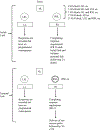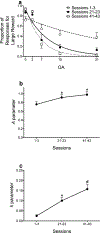Using a dependent schedule to measure risky choice in male rats: Effects of d-amphetamine, methylphenidate, and methamphetamine
- PMID: 31120280
- PMCID: PMC7317298
- DOI: 10.1037/pha0000300
Using a dependent schedule to measure risky choice in male rats: Effects of d-amphetamine, methylphenidate, and methamphetamine
Abstract
Risky choice is the tendency to choose a large, uncertain reward over a small, certain reward, and is typically measured with probability discounting, in which the probability of obtaining the large reinforcer decreases across blocks of trials. One caveat to traditional procedures is that independent schedules are used, in which subjects can show exclusive preference for one alternative relative to the other. For example, some rats show exclusive preference for the small, certain reinforcer as soon as delivery of the large reinforcer becomes probabilistic. Therefore, determining if a drug increases risk aversion (i.e., decreases responding for the probabilistic alternative) is difficult (due to floor effects). The overall goal of this experiment was to use a concurrent-chains procedure that incorporated a dependent schedule during the initial link, thus preventing animals from showing exclusive preference for one alternative relative to the other. To determine how pharmacological manipulations alter performance in this task, male Sprague-Dawley rats (n = 8) received injections of amphetamine (0, 0.25, 0.5, 1.0 mg/kg), methylphenidate (0, 0.3, 1.0, 3.0 mg/kg), and methamphetamine (0, 0.5, 1.0, 2.0 mg/kg). Amphetamine (0.25 mg/kg) and methylphenidate (3.0 mg/kg) selectively increased risky choice, whereas higher doses of amphetamine (0.5 and 1.0 kg/mg) and each dose of methamphetamine impaired stimulus control (i.e., flattened the discounting function). These results show that dependent schedules can be used to measure risk-taking behavior and that psychostimulants promote suboptimal choice when this schedule is used. (PsycInfo Database Record (c) 2020 APA, all rights reserved).
Conflict of interest statement
The authors have no conflicts of interest.
Figures






Similar articles
-
Pair housing, but not using a controlled reinforcer frequency procedure, attenuates the modulatory effect of probability presentation order on amphetamine-induced changes in risky choice.Behav Brain Res. 2020 Jul 15;390:112669. doi: 10.1016/j.bbr.2020.112669. Epub 2020 May 15. Behav Brain Res. 2020. PMID: 32417278 Free PMC article.
-
Methamphetamine increases risky choice in rats, but only when magnitude and probability of reinforcement are manipulated within a session.Pharmacol Biochem Behav. 2024 Jun;239:173751. doi: 10.1016/j.pbb.2024.173751. Epub 2024 Mar 26. Pharmacol Biochem Behav. 2024. PMID: 38548247 Free PMC article.
-
Effects of 7-day continuous D-amphetamine, methylphenidate, and cocaine treatment on choice between methamphetamine and food in male rhesus monkeys.Drug Alcohol Depend. 2015 Oct 1;155:16-23. doi: 10.1016/j.drugalcdep.2015.08.022. Epub 2015 Sep 2. Drug Alcohol Depend. 2015. PMID: 26361713 Free PMC article.
-
Examining the neurochemical underpinnings of animal models of risky choice: Methodological and analytic considerations.Exp Clin Psychopharmacol. 2019 Apr;27(2):178-201. doi: 10.1037/pha0000239. Epub 2018 Dec 20. Exp Clin Psychopharmacol. 2019. PMID: 30570275 Free PMC article. Review.
-
Pharmacotherapy of methamphetamine addiction: an update.Subst Abus. 2008;29(3):31-49. doi: 10.1080/08897070802218554. Subst Abus. 2008. PMID: 19042205 Free PMC article. Review.
Cited by
-
Pair housing, but not using a controlled reinforcer frequency procedure, attenuates the modulatory effect of probability presentation order on amphetamine-induced changes in risky choice.Behav Brain Res. 2020 Jul 15;390:112669. doi: 10.1016/j.bbr.2020.112669. Epub 2020 May 15. Behav Brain Res. 2020. PMID: 32417278 Free PMC article.
-
Neuronal activity associated with cocaine preference: Effects of differential cocaine intake.Neuropharmacology. 2021 Feb 15;184:108441. doi: 10.1016/j.neuropharm.2020.108441. Epub 2020 Dec 16. Neuropharmacology. 2021. PMID: 33340530 Free PMC article.
-
When Helping Is Risky: The Behavioral and Neurobiological Trade-off of Social and Risk Preferences.Psychol Sci. 2021 Nov;32(11):1842-1855. doi: 10.1177/09567976211015942. Epub 2021 Oct 27. Psychol Sci. 2021. PMID: 34705578 Free PMC article.
-
Effects of oxycodone on sensitivity to reinforcement magnitude: implications for effects of opioids on impulsive and risky choice.Behav Pharmacol. 2020 Apr;31(2&3):221-232. doi: 10.1097/FBP.0000000000000543. Behav Pharmacol. 2020. PMID: 31922965 Free PMC article.
-
SK609, a novel dopamine D3 receptor agonist and norepinephrine transporter blocker with putative pro-cognitive actions, does not induce psychostimulant-like increases in risky choice during probabilistic discounting.Psychopharmacology (Berl). 2025 Jun;242(6):1291-1301. doi: 10.1007/s00213-024-06727-1. Epub 2024 Dec 4. Psychopharmacology (Berl). 2025. PMID: 39630237 Free PMC article.
References
-
- Aparicio CF, Hughes CE, & Pitts RC (2013). Impulsive choice in Lewis and Fischer 344 rats: effects of extended training. Conductual 1, 22–46.

